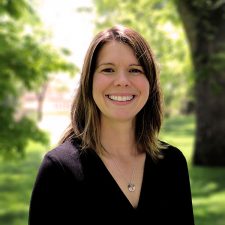 Rebecca Moritz is CSU’s biosafety director and director of the Office of Research Collaboration and Compliance. She is the president of the American Biological Safety Association International. She’s responsible for lab safety at the university and leads the organization that sets professional standards for lab safety worldwide. She will work with scientists to ensure the safe operation of a proposed, new $10 million bat research facility at Foothills Campus.
Rebecca Moritz is CSU’s biosafety director and director of the Office of Research Collaboration and Compliance. She is the president of the American Biological Safety Association International. She’s responsible for lab safety at the university and leads the organization that sets professional standards for lab safety worldwide. She will work with scientists to ensure the safe operation of a proposed, new $10 million bat research facility at Foothills Campus.
Q: How does CSU help protect people from pandemics?
A: Part of CSU’s research mission is to better understand how agents and diseases affect humans and animals. This includes investigating the various ways pathogens transmit between species. Other aspects of the research mission are to test potential vaccines and therapeutics for a variety of agents and diseases and develop new detection technologies. For example, CSU researchers helped in the COVID-19 response locally and at the state and national levels by creating new rapid tests, studying what species can be infected with SARS-COV-2, providing testing for students and a variety of groups in Larimer County and studying transmission parameters, among other areas.
Q: Why is animal research important? Why study animal viruses?
A: Many pathogens can infect both animals and humans. Understanding how this happens in nature is important for understanding disease transmission and evolution. Due to global warming and population growth, humans and animals are coming into contact more frequently and in ways not previously seen. This could result in an increased number of outbreaks and possibly pandemics.
Q: Why study bats?
A: Different bat species are thought to carry a wide variety of different viruses such as SARS-CoV-2, MERS-CoV, rabies, Ebola virus, Nipah virus and Marburg virus, among other pathogens. These pathogens do not make bats sick, but they can transmit the viruses they carry to humans and other mammals. Understanding how this transmission occurs and how bats carry these viruses could provide critical information to better protect global public health and help the world better identify outbreaks and prepare for the next pandemic.
Q: What’s the new bat facility for? What are the limitations of the facility?
A: The new bat facility is designed to primarily house breeding colonies. For safety and science integrity, it’s better to have a self-contained population of bats. It will have some spaces that will be biosafety level 2 labs where experiments can be conducted. However, the types of agents that can be used at BSL-2 are limited to those determined to not be high risk to people and the environment.
Q: How do you ensure infectious bats don’t come here or escape?
A: Bats must go through a quarantine period and testing process to ensure they do not carry any viruses or diseases before they can come to our facility. Once we establish a bat colony it becomes closed. The facility is designed to keep bats inside of their housing areas. In addition, animal care staff and researchers have processes in place to make sure bats stay in their housing areas and are handled appropriately.
Q: Does CSU do gain-of-function research?
A: Gain-of-function is when any organism gains a new ability or property. Some of these functions can be positive. For example, plants that are more drought tolerant or making mosquitos resistant to transmitting dengue fever. However, there is a subset of gain-of-function experiments that pose certain safety and security concerns. CSU has no plans to conduct gain-of-function research of concern.
Q: Is CSU engaged in bioweapons research?
A: No. In 1975, President Ford signed the International Bioweapons Convention, making it illegal to develop, produce, stockpile, acquire, or retain biological weapons.
Q: How do you ensure biological research at CSU is safe?
A: We do everything possible to decrease the risks of our research. Those risks are mitigated by the types of facilities, personal protective equipment, training, policies and procedures our researchers utilize. We acknowledge that there is no such thing as zero risk in research, and in doing so, we are especially careful in our preparation and procedures.
Q: How will CSU protect the community if a researcher is potentially exposed to a pathogen?
A: CSU works closely with local occupational medicine and infectious disease physicians and Larimer County Department of Public Health and Environment to develop plans and procedures to quarantine, test and potentially provide treatment to a researcher who would have a known potential exposure or develops symptoms of an agent they have been working with.